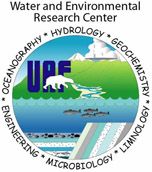

 |
 |
||
 |

Intersections of water, |
||
Resource Vulnerability and Projected Demand
Vulnerability
Similar to the resource suitability index, watersheds were indexed with respect to future vulnerability. The vulnerability index is a function of groundwater contribution, watershed area, and permafrost changes. A less vulnerable watershed would have significant groundwater contribution, suggesting that it is not immediately susceptible to changes in precipitation and not likely perched upon permafrost, which could thaw, leading to drainage. A low vulnerability watershed (in terms of volume) would also have a relatively large watershed as limited watersheds have limited catchment and therefore possibly insufficient flows to meet water demands. Finally, a less vulnerable watershed would have minimal permafrost changes predicted for the coming century. In places, surface water can be perched above the level of groundwater, kept on the surface by permafrost. When permafrost thaws, therefore, there is the potential for drainage of surface water to the subsurface.
In order to produce the suitability index, the output of permafrost modeling was summarized for specific watersheds as delineated by RiverTools, a program that takes a digital elevation model and constructs likely drainage patterns.
The suitability and vulnerability indices discussed here are more fully described in Chambers et al. (in review).
Future Demand
Figure 1. Estimates of domestic water demand on Seward Peninsula through 21st century.
Domestic water demand is expected to depend on population, technology and supply. Assuming a population growth of 1 to 3% per year and infrastructure upgrades to piped water delivery for all Seward Peninsula residents in the coming years, Figure 1 shows several scenarios of water demand. While the average daily use per person per day is 250 gallons in the contiguous United States, estimates for current use in Seward Peninsula communities with piped water are closer to 100 gallons per person per day. A moderate estimate assumes 2% per year population growth and use at 150 gpcpd.
Likely industrial water demands are seafood processing plants, mining and milling, and agriculture. Estimates of mining and milling operation water use can be somewhat guided by water use of currently operating mines and mills. The Rock Creek facility near Nome is beginning operation and has filed water use permit applications. Agriculture has the potential for significant water demand. Current reindeer herding or similar grazing of suitable animals has minimal demand whereas irragated crops would be much more water intensive. Should earlier springs and later falls extend the growing season to a practical scale for cultivation of Alaskan crops, the Seward Peninsula could benefit by producing more food locally, reducing reliance on transported food. Such agriculture would require wise managment of water resources.
This material is based upon work supported by the National Science Foundation under Grant No. OPP-0328686. Any opinions, findings, and conclusions or recommendations expressed in this material are those of the authors and do not necessarily reflect the views of the National Science Foundation. UAF is an affirmative action/equal opportunity employer and educational institution. The University of Alaska Fairbanks is accredited by the Northwest Commission on Colleges and Universities.
|
_